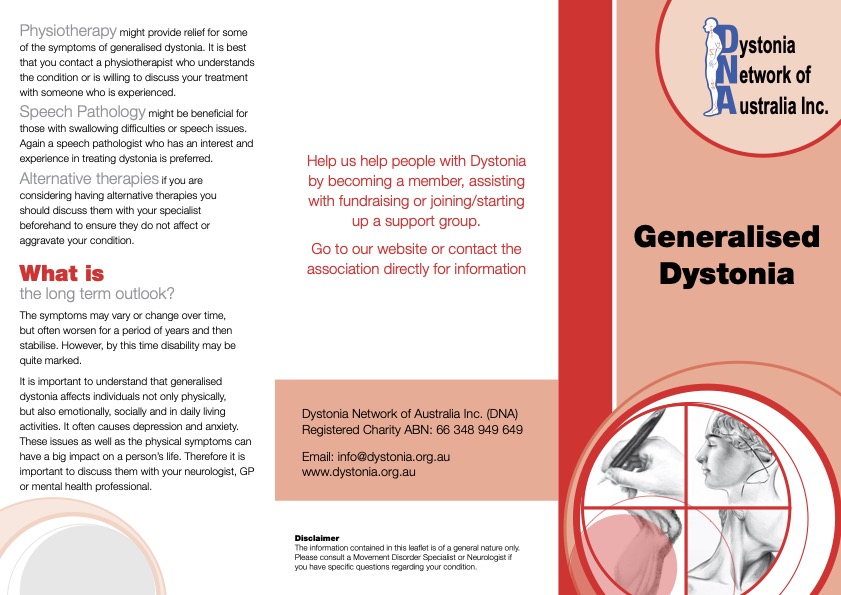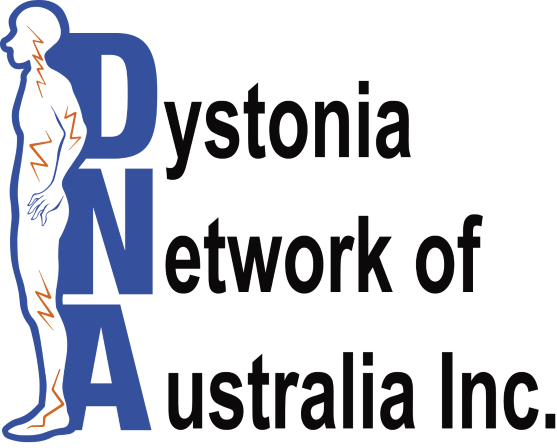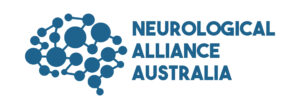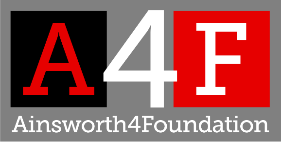What is generalised dystonia?
Generalised dystonia is a rare type of dystonia (least common type) where many areas of the body including the trunk (central or main part of the body) can be affected by muscle spasms that cause twisting movements, resulting in abnormal positions or postures of different parts of the body. The muscle spasms can lead to sustained abnormal postures or repetitive movements that occur from time to time, and often become worse with action.
There are different types of generalised dystonia including the following:
Early-onset generalised dystonia: this type of dystonia often begins with a leg, and then over time spreads to other areas including the trunk and is associated with marked disability. Even in known genetic cases not all carriers will necessarily be affected, for example in DYT1, only about 30% of children, teenagers and young adults with the gene will have symptoms; this is called reduced penetrance.
Dopa-responsive dystonia: this type of dystonia responds well to dopamine, an important chemical messenger in the brain. This means that many of the symptoms of generalised dystonia may improve considerably with the dopamine medications.
Myoclonus dystonia: a dystonia where there are quick, jerky movements of mostly the upper body including the arms. Sometimes it includes other dystonia symptoms such as muscle spasms and abnormal postures. Rarely does the jerking include the legs. In some individuals the condition worsens over time, but in others it can improve.
What causes generalised dystonia?
Generalised dystonia may have a genetic cause but it can also occur without any known cause or be secondary to another neurological condition such as Wilson’s disease (a genetic, metabolic disease which prevents the elimination of copper), cerebral palsy or severe brain trauma. Some genes that are known to be responsible for generalised dystonia are as follows:
- Early onset dystonia — the TOR1A gene (DYT1)
- Dopa-responsive dystonia — GCH1 or TH genes (DYT 5a/5b/14)
- Myoclonus dystonia — the SGCE gene (DYT11).
How is generalised dystonia diagnosed?
Diagnosis is made by a specialist movement disorder neurologist. They will take into consideration the history, clinical signs and symptoms and perform an extensive neurological examination. When a genetic cause is suspected, a referral to a geneticist (specialist in genetics) will be considered. Other testing such as a specialised scan, magnetic resonance imaging (an MRI scan) or blood and urine tests, may also be ordered.
What treatments are available?
Oral medications have been found to be more beneficial in young individuals with generalised dystonia with less side effects than in older people, in particular baclofen, a medication to reduce spasm, and anticholinergic medications. As discussed, in dopa-responsive dystonia medications that replace dopamine in the brain are most often effective.
Some specialists may routinely trial a dopamine medication when the diagnosis of generalised dystonia is made and no direct cause is found.
Botulinum toxin injections may be used in certain areas that are causing pain or discomfort or interfering with function. However, there is a limit to the amount of toxin that can be used with each treatment and treatments need to be repeated usually every 3 – 4 months. This widely used and clinically safe substance is injected into the muscles reducing the spasms and the over-activity of the muscles by weakening them.
Deep Brain Stimulation (DBS) may be considered for certain types of generalised dystonia. DBS is a neurosurgical procedure used successfully for people with dystonia for around fifteen years. It is not a cure but a valid treatment option. In DBS for dystonia, electrodes are implanted deep in the brain. The electrodes are attached to extension cables passed under the skin of the scalp and neck to a battery/stimulator usually placed in the chest wall under the skin. It is similar to a cardiac pacemaker. Stimulation of the electrodes assists in controlling the abnormal movements of dystonia but its action is not completely understood. Please refer to the DBS brochure for more information.
Physiotherapy might provide relief for some of the symptoms of generalised dystonia. It is best that you contact a physiotherapist who understands the condition or is willing to discuss your treatment with someone who is experienced.
Speech Pathology might be beneficial for those with swallowing difficulties or speech issues. Again a speech pathologist who has an interest and experience in treating dystonia is preferred.
If you are considering alternative therapies you should discuss them with your specialist beforehand to ensure they do not affect or aggravate your condition.
Please see our Allied Health page for a list of allied health professionals, such as physiotherapists and speech pathologists who are experienced in treating people with neurological conditions. Please note that the list is not exhaustive.
What is the long term outlook?
The symptoms may vary or change over time, but often worsen for a period of years and then stabilise. However by this time disability may be quite marked.
It is important to understand that generalised dystonia affects individuals not only physically, but also emotionally, socially and in daily living activities. It often causes depression and anxiety.
These issues as well as the physical symptoms can have a big impact on a person’s life. Therefore, it is important to discuss them with your neurologist, GP or mental health professional.
Download Brochure

Brochure – Generalised Dystonia – Download PDF
Not a member? Join today to assist us to continue to provide resources
Disclaimer: The information contained on this page is of a general nature only. Please consult a Movement Disorders specialist or neurologist if you have specific questions regarding your condition.
Page reviewed 31 January 2024




